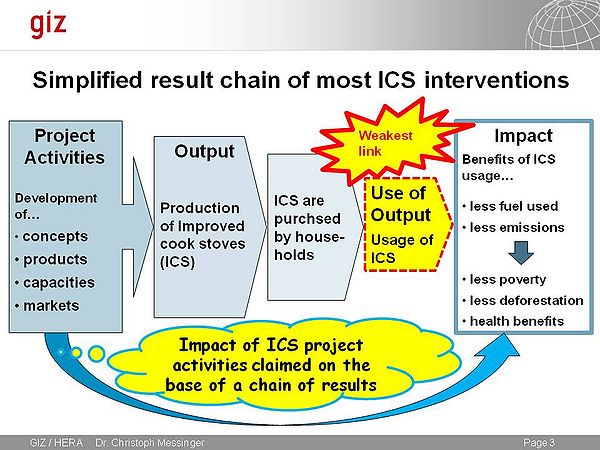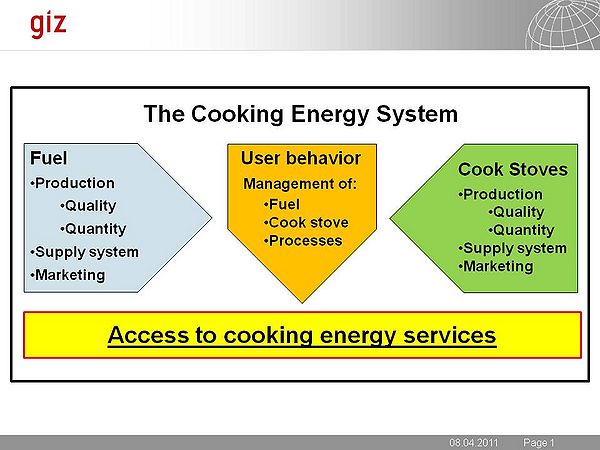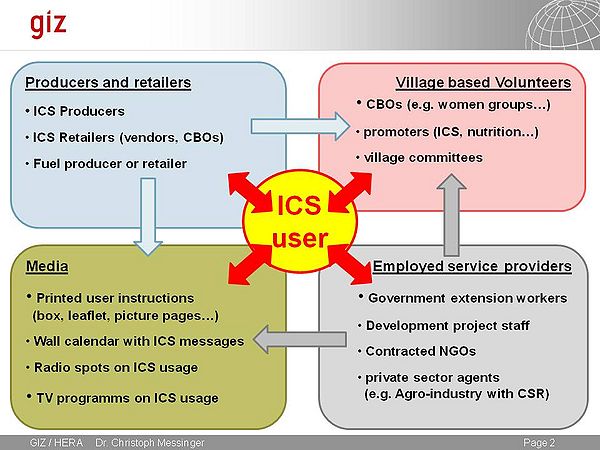Improved Cookstoves (ICS) - User Training
Cooking Energy System | Basics | Policy Advice | Planning | Designing and Implementing ICS Supply | Designing and Implementing Woodfuel Supply | Climate Change | Extra
The Need for Training Users of Improved Cookstoves (ICS)
User training on improved cookstoves (ICS) is probably the most neglected aspect within the ICS promotion process. For an outsider who does not cook on an ICS, the use of it looks so simple that the need for trainings seems to be negligible. However, this can turn out to be an expensive oversight.
The impact chain that describes the core principle of ICS programs in a reduced and simplified form (see above) reveals an important fact: the production of an ICS through an artisan or the purchase of an ICS by the target group does not deliver any development benefit by itself. Only the quantity and quality of the usage decides whether or not the household will realize the potential impacts which are entailed in the product properties.
In most cases, a lot of effort is given on developing the product and the market. However, like any other chain, even the impact chain is only as strong as its weakest link:
- If stoves are just acquired but not used, they do not deliver any benefit to the owner.
- If the stove owner is using the ICS not adequately, the impact of its use will be small.
Hence, if we do not pay the necessary attention to the fostering of the correct practices linked to the use of the new device, this element in the result chain will be the weakest link which is limiting the achievement of the desired development impacts.
Any device comes with a set of requirements related to the behavior, knowledge, and skill of the user. In most cases we are not aware of these requirements until something goes wrong. In such cases we tend to blame ourselves if it is a well known device (e.g. when we fall off a bicycle). But if it is a new device, we tend to blame the device instead of ourselves (“that thing does not work!”). Only after we have learnt how the device should be handled we can distinguish between faulty devices and wrong user behavior.
The training of users facilitates a process in which the user manages to realize the technical potential of the device in his or her day to day practice.
But why should the promoter of a new device feel responsible for the training of its users?
| Aspect of User training | Motivation for user training |
|---|---|
| Safety of usage | Avoidance of compensation claims for negative health implications caused by faulty usage of the device |
| Efficiency of usage | Customer satisfaction = attraction for new customers, and retaining existing clients Avoidance of customer complaints (replacement, refund) Avoidance of bad reputation |
| Durability: Careful usage/ maintenance | |
| Convenience of usage |
User training in industrialized countries has two motivations:
- Safety and durability issues are driven by a customer rights approach. If customers are not properly instructed, they can claim if products do harm them or do not last according to the warranty period.
- The promotion of efficiency and convenience of usage are rather a matter of securing customers satisfaction.
In developing countries, the possibility of rural households to legally claim compensation due to the poor performance of an ICS rarely matters. However, customer satisfaction is highly important for the promotion of a new product in rural communities. Once the reputation of the improved stove is tainted, it will be difficult to restore the lost trust even after design changes, etc.
The Content of the Training of ICS Users
The cooking energy system of a household comprises the fuel and its management, the cook stove, and the user behavior before, during, and after the the cooking process.
User Training on Fuel Management
Different types of fuel for cooking, such as firewood, charcoal, kerosene, biogas, LPG etc. have different needs for management practices. They are related to the access, storage, and preparation for use of the fuel as well as the safety in the house.
This dimension of user training is particularly necessary if the introduction of a new stove requires a “fuel switch” and the household has to learn how to handle a new fuel. But even with firewood, many practices for the efficient handling of the fuel are often not known.
User Training on Stove Management
Users need to know where to place and how to prepare, light, regulate (high and low power), extinguish, clean, maintain and store the stove. They also need to know how to identify malfunctions and what to do if a malfunction occurs.
User training on process management
Knowledge and skills for cooking are passed on from generation to generation in an internal family “user training” process. Mostly knowledge is gained through observation, imitation, and in a trial-and-error approach. But there are also scenarios where external training on kitchen management skills is important. (see General Kitchen Management Practices)
- If access to firewood traditionally has not been a problem, we cannot assume that skills and knowledge on efficient firewood usage have been developed. And even after firewood has become a scarce or expensive commodity, some people may lack the understanding of the physics of the cooking process to come up with new cooking knowledge regarding the need to save firewood. In this case, training on energy saving cooking practices is helpful.
- In some regions, young girls are allocated cooking responsibilities in their early teens. They do not know much about cooking efficiencies etc. With weakening social cohesion of traditional societies, they have no chance to learn good cooking practices.
- In some regions, the high prevalence of HIV has reduced the generation of the fathers and mothers (app. 15-45 years) drastically. Traditional knowledge gets lost and the internal family “user training” may not happen. Hence there are more and more children headed households which do not learn how to cook efficiently.
- Cooking in refugee situations may confront households to prepare strange foods in a different household environment. They have to develop a new set of cooking practices suited to their (temporary) new environment.
The Forms of the ICS User Training
Knowledge and skills on the appropriate use of as fuel-stove cooking system can be disseminated in a variety of forms.
Printed Instructions (text, signs, comics): (Examples: Media resources and tools used by GIZ)
- User manual (leaflet)
- On the box
- Posters, banners
- Wall-Calendars
- T-shirts, skirts,
- Bags
- Newspaper
“Aired” Instructions (radio, TV):
- Information spot
- a drama (video or audio)
Public Demonstrations (roadside stand, markets, shows, village meetings…):
- Theatre play
- Demonstration (showing and explaining) of correct usage
- Cooking competition (good versus poor user practices)
Personal Instructions (sales talk, women group, home visit…)
- Demonstration of correct usage
- Question and Answer service
- Observation and correction of current usage
- Discussion on “What is a good user practice? – and – Why is it good?”
More on the methodology of “raising awareness” can be found here.
The Agents for the Training of ICS Users
The training of users on the management of the stove, the fuel, and the cooking process can be done by a variety of agents (see the following diagram).
Producers and Retailers
In industrialised countries, producers and particular the retailers of products offer advice to potential customers in the sales process. The cost of the user training if financed by the sale of the products. For high value products, companies offer even training courses on their technologies or the visit of one of their employees at the customers premises. In developing countries, the scope for these aproaches is limited. If the stove is sold directly to the customer, the producer instructs the user, particularly if they are living in the same community. However, stoves are also sold at distant places such as markets, roadside etc. or through retailers (e.g. door-to-door vendors, women groups). If the access to fuel is also commercial, the fuel vendors can also play a role in advising on fuel management.
Media
In industrial countries, most of the user training is done in a non-personal way. Nearly every product is sold with a printed user instruction on the package or as leaflet or manual inside the box. This can be as text, drawings or a combination of the two.
For the promotion of efficient stoves in developing countries, however, there are limitations to this approach including:
- the low level of literacy
- ICS are low cost products for poor people which does often not allow for additional costs of a box with instructions
As a result, producers rarely use this opportunity for user instructions. Often, it is rather the projects which pay for awareness materials on proper ICS design and use.
Other non-personalised ways to reach ICS users are wall calenders, radio spots and TV shows. This is often a combined promotion of awareness on the product (promotion) and its proper usage. However, in remote areas this approach might be limited by the availablility and access to mass media.
-> (See Creation of public awareness for ICS)
Village Based Volunteers
Community-help structures offer user training to community members based on social coherence values. Women groups, faith communities or individual community members help to train other community members on required user knowledge without pay.
Employed Service Providers
The training of ICS users in developing countries is often regarded as part of a public mandate. Government extension workers, project staff or contracted NGOs reach out to communities to train on the efficient management of the stove, the fuel, and the cooking process. In some cases, the extension services of the out-grower-schemes (see glossary) within the private sector agro industry take over a role in the user training as part of a corporate social responsibility practice.
These external agents often train village volunteers for the community based on user training processes described above. However, there are also other approaches often used at public places, such as village meetings, market places, or agricultural shows.
These include:
- Cooking competitions to demonstrate the effect of good and bad practices on the quality of ICS performance (speed, fuel consumption, smoke);
- Theatre play to raise awareness on “wrong versus recommended” ICS practices;
- Display of devices, question and answer services (e.g. at agricultural shows).
Village based volunteers and media are often used by employed service providers and – to a smaller extent – by producers and retailers to support the implementation of their user trainings.
Financing and Sustainability of the User Training
Employed service providers are the most effective way for comprehensive user training, often through involving village based volunteers. Theatre and media are strong tools to create awareness on wrong and good practices. However, these types of interventions are based on external financing and will not continue once the external funding has ceased.
Stove producers and their retailers will not create sufficient income to afford user training at a similar level based on the revenue they generate from the sales of household stoves. However, this does not seem to be necessary in the long run if the external agents are managing to create sufficient local knowledge within the communities about the “new device”. Once a critical mass of potential multipliers in the community follows the right practices, the internal “user training” can continue without external stimulus. The device has become a “common good”. Thereafter, the innovation is no longer “new” and therefore the demand for user training will be limited and manageable inside the community.
References
This article was originally published by GIZ HERA. It is basically based on experiences, lessons learned and information gathered by GIZ cook stove projects. You can find more information about the authors and experts of the original “Cooking Energy Compendium” in the Imprint.























